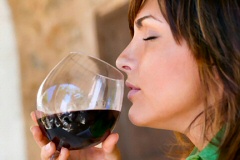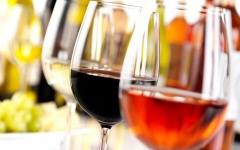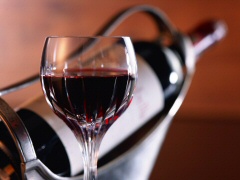|
 When you're wine tasting, you undoubtedly hear the terms aroma and bouquet tossed around. You've perhaps even considered them to be one in the same, as they are used so interchangeably. And, while they are indeed related, there is a distinct difference between the two. When you're wine tasting, you undoubtedly hear the terms aroma and bouquet tossed around. You've perhaps even considered them to be one in the same, as they are used so interchangeably. And, while they are indeed related, there is a distinct difference between the two.
Before we address this difference, let's briefly review a couple of overarching topics. First off, why does wine have such unique scents to begin with? The answer to this question is rooted in biology: it's believed that aromatic compounds are tools that aide in a vine's survival by attracting insects to assist in pollination and birds and other animals to eat the berries and disperse seeds.
This same trick seems to have attracted Homosapiens as well! Our sense of smell and detection of aromas when we drink wine is in fact how we taste wine; the flavors each of us recognize and individually distinguish determines if we are particularly fond of a specific wine or not. All of those flavors you detect in a wine, whether it be fruity, floral, earthy, woodsy, herbal, vegetal or mineral qualities are all perceived through what we detect with our combined olfactory senses.
And, yes, every individual's sense of smell and palate differs, and each of us may explain a similar flavor differently. This explains why two people sampling the same wine may describe aromas they perceive differently.
 Wine aromas can be broken down into three main categories: primary, secondary and tertiary aromas. Primary aromas are associated with a specific grape varietal used to produce a wine, often called "varietal aromas." Secondary aromas are developed during the process of pre-fermentation and fermentation and are referred to as "vinous aromas." Lastly, tertiary aromas develop during the post-fermentation phase in the wine-making process when the wine is maturing either in a barrel or later in a bottle. Wine aromas can be broken down into three main categories: primary, secondary and tertiary aromas. Primary aromas are associated with a specific grape varietal used to produce a wine, often called "varietal aromas." Secondary aromas are developed during the process of pre-fermentation and fermentation and are referred to as "vinous aromas." Lastly, tertiary aromas develop during the post-fermentation phase in the wine-making process when the wine is maturing either in a barrel or later in a bottle.
In official wine terminology, the primary and secondary aromas are really the only actual "aromas", and tertiary aromas are actually considered to be a wine's "bouquet." So, an easy way to think of it is that aromas are associated with the wine before its aged or bottled. Any scents/flavors acquired after that due to changes in the wine's chemistry, imparted scents from aging material (e.g. oak barrels) are all part of a wine's bouquet. The process of the wine aging first in barrels and then later in bottles is in fact blending aromas to make new aromas, and this is also casually referred to at times as creating a wine's "perfume."
Of course, this explains why a premium wine that has been allowed to sufficiently age will offer a complex bouquet and a young, immature wine will be lacking in bouquet. Developing a bouquet takes time and is an evolution; this explains why you've heard that a bottle of wine will never taste precisely the same as one identical to it if you open them at different times. We do not mean to say that a wine is boring while it is young. In fact, during the fermentation process and immediately afterward at the start of its creation, a wine's overall aromas change more rapidly than at any other point during its existence.
 While we're talking tasting wine, let's mention that wine served at warmer temperatures will offer more detectable aromas than wine that's served cooler. And, that person at the wine bar that loves to over-exaggerate their wine-swirling by claiming that they want to "get some air into the wine" to open it up? Well…they are actually not wrong at all, even if they are perhaps a little over-zealous. Aerating a wine will certainly do good things to it, and don't be at all afraid to use your decanters at home that are patiently awaiting your attention. While we're talking tasting wine, let's mention that wine served at warmer temperatures will offer more detectable aromas than wine that's served cooler. And, that person at the wine bar that loves to over-exaggerate their wine-swirling by claiming that they want to "get some air into the wine" to open it up? Well…they are actually not wrong at all, even if they are perhaps a little over-zealous. Aerating a wine will certainly do good things to it, and don't be at all afraid to use your decanters at home that are patiently awaiting your attention.
Professional wine-tasters will often smell a wine before they swirl and then sniff again, as some subtle aromas can be overwhelmed with rapid aeration. And, it's actually recommended to take a few quick sniffs rather than one prolonged one, as your olfactory senses will be more likely to pick up differing scents in this manner.
So, what are typical primary and secondary aromas that we notice in certain wines? There is grassiness and herbs in Cabernet Sauvignon and Sauvignon Blanc. Floral aromas are often associated with Riesling and Gewϋrztraminer. Berries are commonly detected in many red wine varietals; black pepper/spice is also a primary aroma in some. Citrus elements are common in many white wines.
Typical tertiary aromas, which we now know to refer to as "bouquet characteristics" as they develop in the post-fermentation process, include: mushroom, caramel, coffee, leather, smoke, prune, toast, roasted nuts, smoke, butter, chocolate and cedar. A few aromas included on this list are direct results of a wine's contact with oak during the aging process prior to bottling. Can you guess which ones?
We would be remiss to not also address another term that is often lumped together with any discussion of aromas that is not so pleasant to our sense of smell and taste. This would the subject of odors, which are scents perceived as unpleasant and can also indicate a fault in a wine. Vegetal aromas were previously mentioned, whose presence in a wine's presentation do not overtly signal a fault, but too much veggie in a wine is rarely perceived as beneficial, very rarely.
You'll often hear a winemaker say that while they have a vintage bottled, they are holding off on releasing it as long as they can. For those eager to try their new exciting-sounding wine, it may at first be confusing to hear that a winemaker doesn't want their wine to be sampled just yet. However, keep in mind that the winemaker is only trying to safeguard their work- they want their wine to be given a chance to develop as much as possible before being opened.
As mentioned earlier, unless they are of spectacular quality, young wines will lack in bouquet. Mass produced wines are not intended to offer endearing bouquets and are designed to be enjoyed for what they are; not having this element present in a wine envisioned to offer a flourishing bouquet is a grave injustice! A winemaker, after all, is a bit of an artist who wants their best work on display.
|